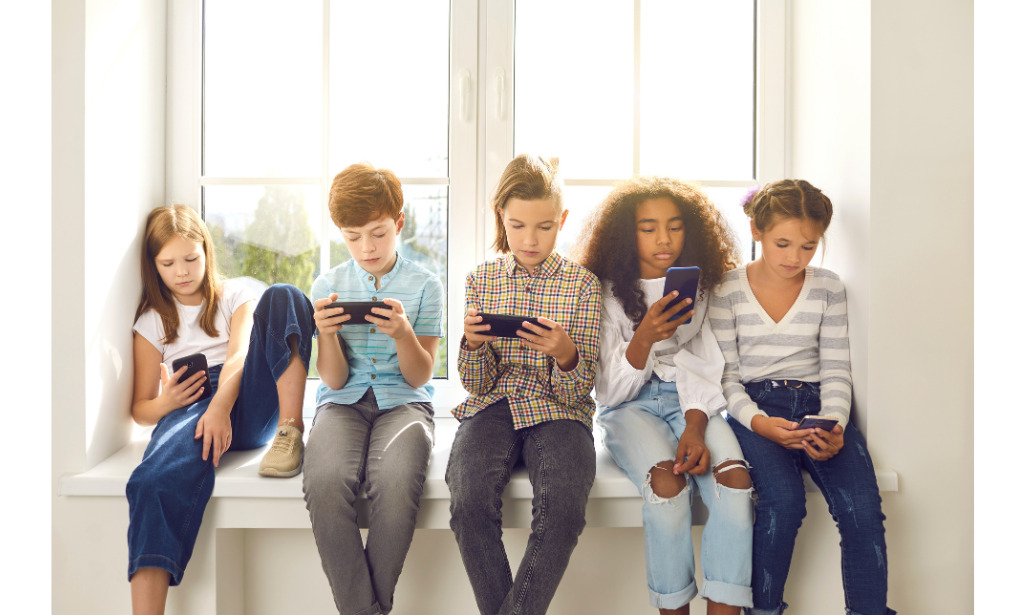We live in a world dominated by screens. TVs, phones, tablets, computers…even cars and some appliances are equipped with giant screens today. There’s no escaping them but, as parents, we can manage our kids’ screen time as much as possible. But what about children who homeschool online? After all, they’re going to be in front of a screen for hours at a time, right? Well, maybe. The key is finding a healthy approach to balancing online homeschooling with other screen time.
Screen Time Is Off the Charts
Parents everywhere know that their children enjoy screen time. But, according to Pew Research findings from 2020, 71% of parents of a child under the age of 12 say they are at least somewhat concerned their child might spend too much time in front of screens, including 31% who are very concerned about this. Additonally, the annual University of Michigan C.S. Mott Children’s Hospital National Poll on Children’s Health showed that 67% of parents rated “overuse of devices or screen time” as their top concern for their teen. Despite these concerns, however, parents still may not know the extent to which tweens and teens are on their devices.
Common Sense Media’s 2021 Census: Media Use by Tweens and Teens offered some very revealing information, as this was their first census that compared screen usage before and after COVID. The types of media activities included in the surveys were watching television (regardless of platform), watching online videos (such as YouTube), using social media, playing video or computer games, playing mobile video games (on a phone or tablet, reading online, using digital devices to create content (art, music, videos, or creative writing), listening to podcasts, and using virtual reality. The census offered separate surveys for both tweens (ages 8 to 12) and teens (ages 13 to 18). The census showed:
- Media use in tweens and teens has grown faster since the start of the pandemic than it did over the four years prior to the pandemic. From 2015 to 2019, media use for tweens grew by only 3%, and for teens by 11%. From 2019 to 2021, however, media use grew by 17% for tweens and teens.
- On average, tweens use about 5-1/2 hours of screen media per day (5:33). Teens use about 8-1/2 hours of screen media (8:39). Between 2019 and 2021, the total amount of screen media used each day went from 4:44 to 5:33 among tweens, and from 7:22 to 8:39 among teens. This represents a much faster increase in just two years than was seen in the previous four years.
- Since 2019, the biggest increases were in time spent watching online videos (up 23 minutes a day among teens), using social media (up 17 minutes a day among teens and eight minutes a day among tweens), and browsing websites (up 14 minutes a day among teens and 10 minutes a day among tweens).
- More than six in 10 tweens and teens watch online videos every day, and say they enjoy watching “a lot”.
- On any given day, just 5% of tweens and 3% of teens don’t engage with screen media at all.
- Among tweens, 47% use more than four hours of screen media a day, including 20% who use more than eight hours. Among teens, 75% use more than four hours of screen media per day, including 41% who use more than eight hours of screen media. The number of tweens and teens using more than eight hours of screen media a day is up from just two years ago, especially among teens (from 29% to 41% of all teens).
- Watching video content, including TV shows and online videos, accounts for the most screen use among both tweens and teens (2:40 among tweens and 3:16 among teens), followed by gaming on consoles, portable players, computers, or mobile devices (1:27 among tweens and 1:46 among teens). Among teens, social media accounts for nearly 90 minutes of daily screen time, while browsing websites accounts for 51 minutes.
Now, if your child is homeschooling online, you’re likely adding at least a couple of hours to the equation. That can add quite a bit of screen time each day. So, how can you break things up to find a healthier balance? Here are a few tips.
Tips for Creating a Healthier Balance of Screen Time
- Set time limits. This is likely a strategy all parents have tried at some point, with varying levels of success. But when enforced, it can be effective. Kids will resist and fight, but you’re the parent, so create a daily screen-time schedule and stick to it. If you know your child will be looking at a screen for hours every school every day, make a schedule that works around school time. For example, they can have screen time from 9-10, school from 11-1, lunch, school from 2-3, screen time from 4-5 and then 7-8. Studies have shown that screen time at or near bedtime is disruptive to the sleep cycle, so getting devices out of their hands a couple of hours before bed is a good idea. How can you enforce this schedule? Well, you can give your child the benefit of the doubt and use the honor system. But if they begin to stray from the schedule, you can always lock their devices or turn off their WiFi access for certain periods of time.
- Mandate reading and physical activity breaks. Staring at a screen all day causes mental and even physical fatigue. If you’re following a schedule, you can use the screen-time gaps to make sure your child is getting the right amount of physical activity and a brain break. If the weather allows, set aside at least an hour in your schedule for outdoor activities. This can involve shooting some hoops, taking some swings in a batting cage, climbing on a jungle gym, having fun on the playground, taking a walk or a nature hike–anything that gets them out into the fresh air and gets their blood pumping. Reading can also be a relaxing change of pace from screen time. Sure, we all want our kids to read the classics and know their literature. But during this break, let them read anything they want so they can recharge their batteries. Comic books, magazines, short stories, graphic novels, or any book that interests them. If it’s a nice day, encourage your child to sit outside and read. Just make sure they’re turning a page and not swiping a screen.
- Mix up their learning. One of the more popular methods of education today is blended learning. Simply put, blended learning is a combination of online learning and traditional paper- and book-based activities. Blended learning offers students the opportunity to give their eyes a rest from the screen and use their hands for something other than typing and scrolling. Better yet, blended learning appeals to all types of learning styles. If your homeschooler is a visual or auditory learner, videos, live classes, and online visuals on the internet (maps, graphic organizers, images, etc.) keep your visual learner engaged while discussions, conversations, and other auditory components will speak right to your auditory learner. The best blended learning classes also include textbooks, printed materials, or additional hands-on projects that help tactile learners reinforce online lessons. Live online classes are also an amazing way to break up the day. Sure, the classes require the use of a computer screen. But with live classes, students become so engaged with the instructor and classmates that they forget they’re even on screen! It feels like they’re in the middle of a real classroom. This encourages conversation, interaction, engagement, and participation, which a child would not really get by scrolling on a device.
- Get them involved in extracurricular activities. Fact: Kids can’t play on their phones when they’re involved in an activity! Getting your child involved in extracurricular activities serves many purposes. For one, they get to meet new people and partake in an activity they enjoy. This could be sports, clubs, music, theater, and any other activities that may be available in your area. Extracurriculars also help kids understand the value of teamwork and community, regardless of what type of activity they join. Finally, participating in extracurricular activities keeps kids off of their devices for a period of time. If you’re unsure what types of extracurricular activities are available to homeschoolers in your area, just do a Google search. You’ll be surprised by how many groups, clubs, leagues, and activities are within driving distance.
Online homeschooling truly is an amazing way to get an education. Whether you go it alone or partner with a homeschool academy like Bridgeway, your child can explore an expansive world of online learning through independent study, online classes, interactive learning companions like Elephango, and live online classes led by a real teacher in a virtual classroom. But as awesome as online homeschooling is, we want to make sure our kids are not spending an inordinate amount of time in front of a screen. By breaking up the day with activities, setting and enforcing a screen-time schedule, and introducing a variety of learning methods and approaches, your student can excel with online homeschooling yet still maintain a healthy balance of screen time.
To learn more about homeschooling online with Bridgeway Academy, call us at (800) 863-1474!













